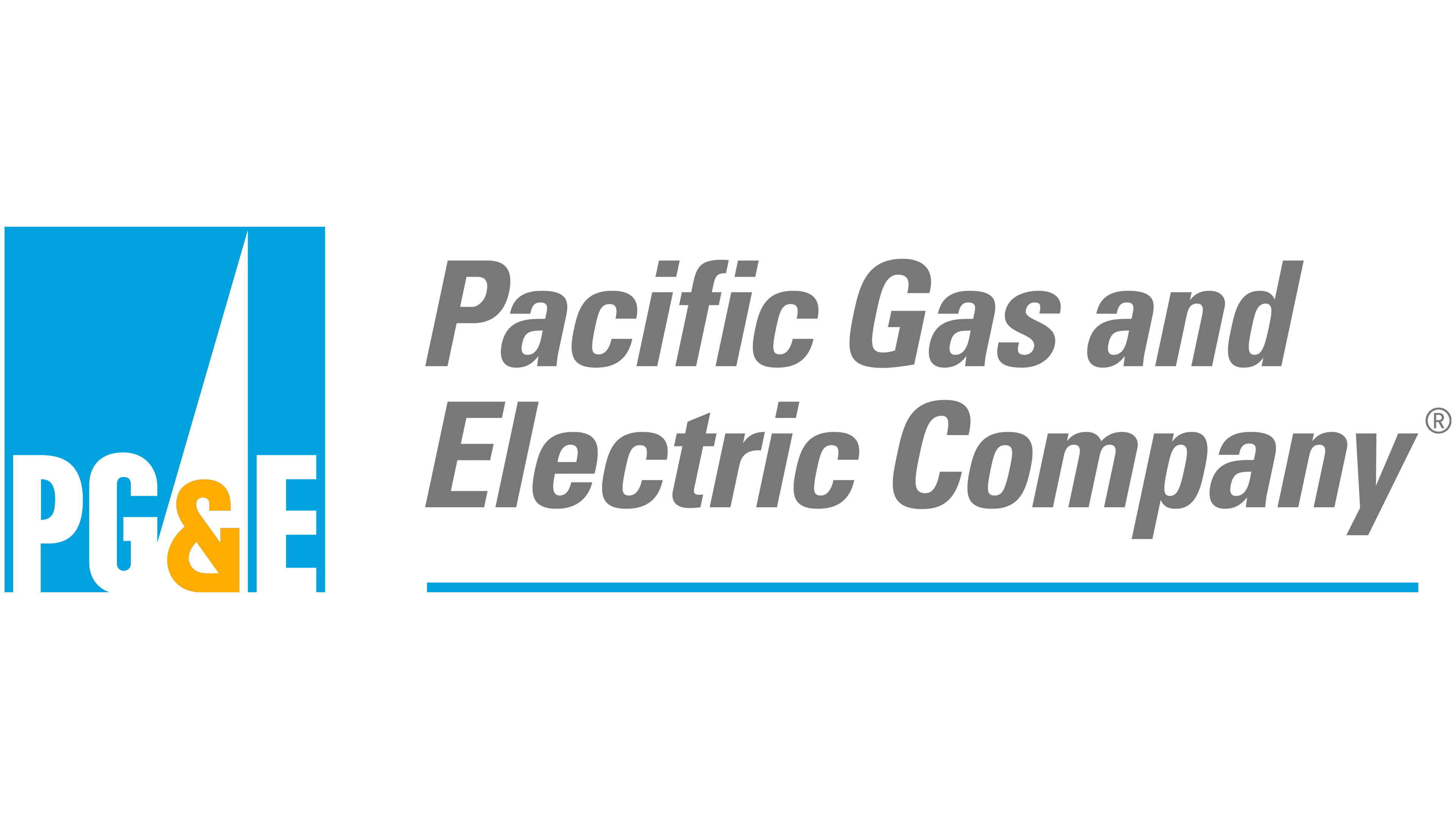In today's rapidly evolving energy landscape, Pacific Gas and Electric Company (PG&E) plays a pivotal role in shaping California's energy future. As one of the largest utility companies in the United States, PG&E has been at the forefront of energy innovation and infrastructure development. Whether you're a homeowner, business owner, or simply someone interested in energy policy, understanding PG&E's operations is essential for navigating California's energy ecosystem.
PG&E has been a cornerstone of California's energy infrastructure since its inception. The company serves millions of customers across the state, providing essential services such as electricity and natural gas. However, the company's journey has not been without challenges, including wildfires, bankruptcy, and regulatory scrutiny. This article aims to provide a detailed overview of PG&E's history, services, challenges, and future prospects.
As we delve into the world of PG&E, we'll explore its operations, the impact of its decisions on California's energy landscape, and how it continues to adapt to the demands of a changing world. Whether you're looking to understand your energy bill or stay informed about energy policy, this guide will equip you with the knowledge you need.
Read also:Who Is Eric Daugherty A Comprehensive Guide To His Life Career And Achievements
Table of Contents
- History of PG&E
- PG&E Services and Operations
- PG&E and Wildfires: A Growing Challenge
- Navigating Bankruptcy: PG&E's Resilience
- Regulatory Environment and PG&E
- PG&E's Commitment to Innovation
- Customer Experience with PG&E
- The Future of PG&E: Trends and Predictions
- PG&E's Sustainability Efforts
- Conclusion: Why PG&E Matters
History of PG&E
Founding and Early Years
Pacific Gas and Electric Company, commonly known as PG&E, was founded in 1905. The company began as a consolidation of several smaller utility companies in California. From its inception, PG&E focused on providing reliable electricity and natural gas services to its customers. Over the decades, the company expanded its service area and invested heavily in infrastructure development.
During the mid-20th century, PG&E played a crucial role in California's industrial growth. The company's investment in hydroelectric power plants and natural gas pipelines helped fuel the state's economic boom. By the 1970s, PG&E had become one of the largest utility companies in the United States, serving millions of customers across northern and central California.
Key Milestones in PG&E's History
- 1905: PG&E is founded through the consolidation of several smaller utility companies.
- 1920s: The company invests heavily in hydroelectric power plants, laying the foundation for its future growth.
- 1950s: PG&E begins constructing natural gas pipelines, expanding its service capabilities.
- 1980s: The company faces regulatory challenges and begins diversifying its energy sources.
Throughout its history, PG&E has been a pioneer in energy innovation, constantly adapting to meet the changing needs of its customers and the regulatory environment.
PG&E Services and Operations
Electricity and Natural Gas Services
PG&E provides essential services to millions of customers across northern and central California. The company's primary offerings include electricity and natural gas distribution. PG&E operates an extensive network of power lines, substations, and pipelines to ensure reliable energy delivery.
In recent years, PG&E has invested heavily in smart grid technology, which allows for more efficient energy management and improved customer service. This technology enables real-time monitoring of energy usage, helping customers better manage their energy consumption and costs.
Energy Efficiency Programs
PG&E offers a variety of energy efficiency programs designed to help customers reduce their energy usage and lower their bills. These programs include rebates for energy-efficient appliances, incentives for solar panel installations, and educational resources on energy conservation.
Read also:Mark Orchard A Comprehensive Guide To His Life Career And Achievements
Through these initiatives, PG&E aims to promote sustainable energy practices and reduce the environmental impact of its operations. The company's commitment to energy efficiency is a key component of its overall sustainability strategy.
PG&E and Wildfires: A Growing Challenge
One of the most significant challenges facing PG&E in recent years has been the increasing frequency and severity of wildfires in California. The company's power lines and equipment have been linked to several major wildfires, including the devastating Camp Fire in 2018.
In response to these challenges, PG&E has implemented a series of measures to mitigate wildfire risks. These include enhanced vegetation management, improved equipment maintenance, and the development of a Community Wildfire Safety Program. The program focuses on identifying high-risk areas and implementing targeted safety measures to protect communities.
Key Initiatives to Combat Wildfires
- Enhanced vegetation management to reduce fire risks near power lines.
- Improved equipment maintenance to prevent equipment failures that could spark fires.
- Development of a Community Wildfire Safety Program to protect high-risk areas.
These efforts demonstrate PG&E's commitment to addressing the wildfire challenge and ensuring the safety of its customers and communities.
Navigating Bankruptcy: PG&E's Resilience
In 2019, PG&E filed for Chapter 11 bankruptcy protection in response to the financial impact of the wildfires. The bankruptcy process allowed the company to restructure its debts and implement necessary safety improvements. Despite the challenges, PG&E has shown remarkable resilience, emerging from bankruptcy in 2020 with a renewed focus on safety and sustainability.
Throughout the bankruptcy process, PG&E continued to provide essential services to its customers, demonstrating its commitment to reliability and customer service. The company's ability to navigate such a complex financial situation underscores its strength and adaptability in the face of adversity.
Regulatory Environment and PG&E
PG&E operates within a highly regulated environment, subject to oversight by the California Public Utilities Commission (CPUC). The CPUC sets rates, reviews safety measures, and ensures that PG&E complies with state and federal regulations. This regulatory framework is designed to protect customers and ensure the safe and reliable operation of PG&E's infrastructure.
In recent years, the CPUC has increased its scrutiny of PG&E's operations, particularly in relation to wildfire safety. The commission has mandated numerous safety improvements and imposed fines for regulatory violations. PG&E's compliance with these regulations is essential for maintaining its license to operate and ensuring the safety of its customers.
PG&E's Commitment to Innovation
Investing in Renewable Energy
PG&E is committed to promoting renewable energy and reducing its carbon footprint. The company has invested heavily in solar and wind power projects, aiming to achieve California's ambitious renewable energy goals. By 2030, PG&E plans to source 60% of its electricity from renewable sources, demonstrating its dedication to sustainability.
Smart Grid Technology
In addition to renewable energy, PG&E is a leader in the development and implementation of smart grid technology. This technology enables more efficient energy management, improved reliability, and enhanced customer service. Through its smart grid initiatives, PG&E is helping to shape the future of energy delivery in California.
Customer Experience with PG&E
Customer Service Initiatives
PG&E places a strong emphasis on customer service, offering a variety of resources and tools to help customers manage their energy usage and costs. The company's website provides detailed information on energy efficiency programs, billing options, and service updates. PG&E also offers a mobile app, allowing customers to monitor their energy usage and receive important notifications on the go.
Through these initiatives, PG&E aims to empower its customers and enhance their overall experience. The company's commitment to customer service is a key factor in its continued success and growth.
The Future of PG&E: Trends and Predictions
Looking ahead, PG&E is poised to continue its leadership role in California's energy landscape. The company's focus on renewable energy, smart grid technology, and wildfire safety positions it well for the challenges and opportunities of the future. As California moves toward a cleaner, more sustainable energy future, PG&E will play a critical role in shaping the state's energy infrastructure.
Key trends to watch include the continued growth of renewable energy, advancements in smart grid technology, and the evolution of wildfire safety measures. PG&E's ability to adapt to these trends will be crucial for its long-term success and sustainability.
PG&E's Sustainability Efforts
Sustainability is a core component of PG&E's mission and strategy. The company has set ambitious goals for reducing its carbon footprint and promoting renewable energy. By investing in clean energy technologies and implementing sustainable practices, PG&E is helping to create a more sustainable future for California and beyond.
PG&E's sustainability efforts extend beyond its operations, encompassing community engagement and environmental stewardship. The company partners with local organizations to promote energy efficiency and environmental conservation, demonstrating its commitment to making a positive impact in the communities it serves.
Conclusion: Why PG&E Matters
In conclusion, Pacific Gas and Electric Company (PG&E) is a vital player in California's energy landscape. From its rich history to its innovative approach to energy delivery, PG&E continues to shape the future of energy in the state. Despite the challenges it has faced, including wildfires and bankruptcy, PG&E has demonstrated remarkable resilience and adaptability.
As California moves toward a cleaner, more sustainable energy future, PG&E's leadership and commitment to innovation will be crucial. By investing in renewable energy, smart grid technology, and wildfire safety, PG&E is helping to create a brighter future for its customers and communities.
We invite you to share your thoughts and questions in the comments section below. Your feedback is valuable in helping us improve and expand our content. Additionally, feel free to explore our other articles for more insights into energy and sustainability topics. Together, we can continue to learn and grow in our understanding of the energy landscape.
Data Source: PG&E Official Website, California Public Utilities Commission (CPUC).


